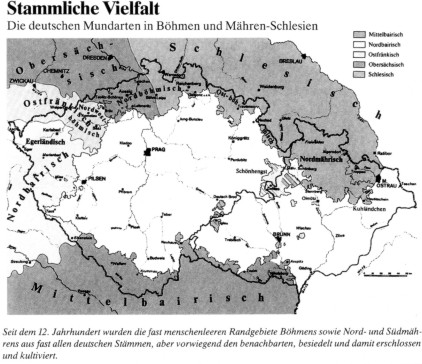|
6.
The great colonization
During the High Middle Ages
the peripheral areas of the Bohemian Massif extended as far as
a day's footmarch and were covered with forests which were
almost impenetrable. Only a few footpaths and wagon trails
crossed it such as the old-famous "Golden Steig"
from Passau through the valley of the Ilz or the trail from
Silesia at Liebau to Nachod. These routes did not only carry
the trade with a multitude of goods, they also brought
settlers into the forest and mountain areas. Their harbingers
were the clergymen, traders, princesses, noblemen and monks
whom the Bohemian court had invited into the land. The German
colonization unfolded with enormous impact around the middle
of the 13th century. It progressed in three parallel streams
of crafts, husbandry and mining. Most often a "Lokator"
was hired by the sovereign to settle colonizers on a
designated piece of land. . His organisational endeavors
usually were awarded with the hereditary title of magistrate
and a guesthouse license as a commission. The newly founded
towns and localities were subject to the legal systems of the
towns and villages from where the settlers came. The
development and administration of German towns became a model
for the construction of the Bohemian towns. King Ottokar II
evidently saw the German colonization as a means of scaling
down the nobility and for increasing his financial and
political power. In addition, towns made bids on their own for
colonists and established villages to fill their need for an
agrarian back country. This led nearly everywhere to the
emergence of groups of towns and villages entailing a rapid
growth of the German-speaking population.
Immigration from various
regions of the Empire is the source for the various
Sudetengerman dialects and to some extend for the differing
architectural styles as well. The names of villages provide
distinct evidence of older Slavic origins (-itz) or of younger
ones related to colonization (-dorf, -berg, -wald). Newly
founded German settlements were usually named by the locator
or the settlers chose a name related to the landscape, whereas
the Slavic public retained an old castle or field name. This
explains that the later introduced official bilingualism often
led to German and Czech place names the meanings of which do
not reveal a relation.
Northern Bohemia was settled
mostly by Lausitzers whose dialect with a rolling
"R" remained a distinctive mark over centuries. Many
monasteries and monastic orders took part in the colonization.
Ancestral
Diversity
The German dialects in Bohemia
and Moravia-Silesia |
|

|
| The
practically unpopulated peripheral areas of Bohemia
as well as South- and North-Moravia were settled,
developed and cultivated by settlers since the 12th
century from almost all German regions, but
predominantly from adjacent ones. |
The German
colonization, the
founding of cities, the development of mining for silver and
a wealth of other minerals made the kingdom of Bohemia
indisputably the empire's most important duchy which
expanded its influence from the Baltic to the Adriatic Sea.
Who would know that Königsberg, East Prussia, was founded
by Ottokar II and that his name is embodied in Ottakring, a
suburb of Vienna. Undeniably, the Bohemian kingdom also
benefited from the weakness of the empire during the "dreadful
interregnum" (1256-1273). At the peak of his power,
Ottokar II saw his plans thwarted by the election of Rudolf
von Habsburg as German king. In a fight for power, he was
defeated and lost his life (battle of Marchfeld). His son
and grandson were not predestinated to good fortune. With
them the male lineage of the Przemyslids died
out and unruly times followed. Nearly anarchic conditions
arose under Heinrich von Kärnten. Nobility and burghers
fought each other and moved the king back and forth like a
chess board figure. The burghers of the cities demanded a
voice in the Landtag, the nobility refused. This was the
first national conflict in Bohemia, for the burghers were
Germans, the nobility mostly Czech.
|